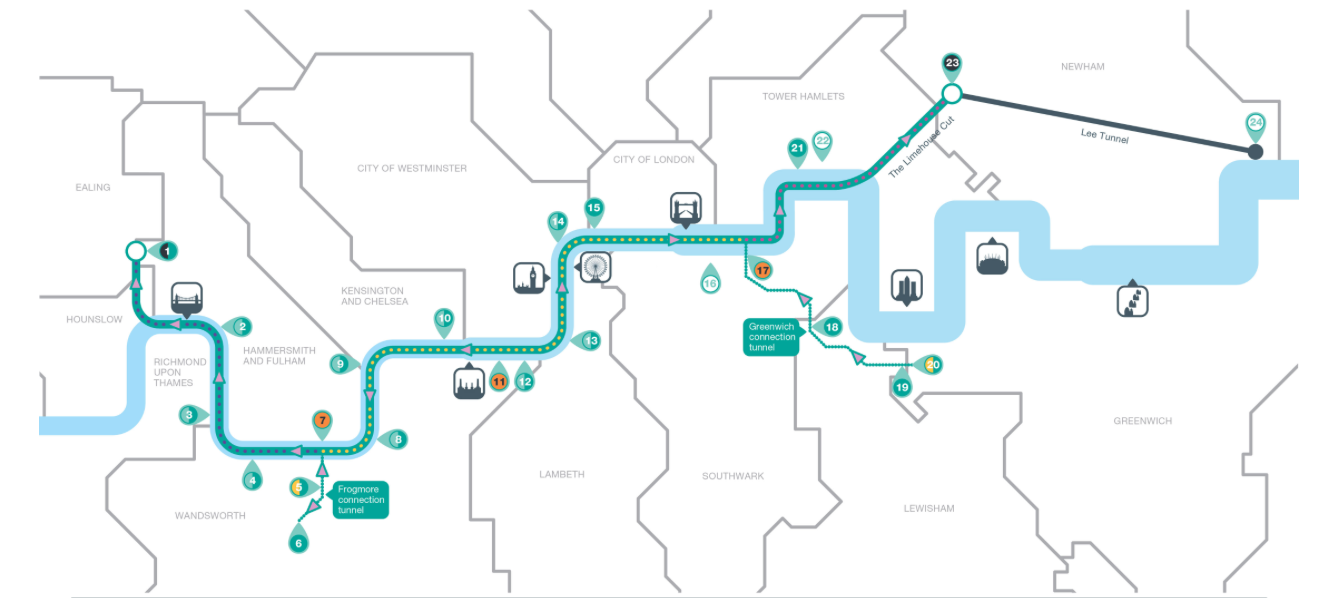Time to talk about the Thames Tideway tunnel

The Thames Tideway tunnel – also known as the ‘super sewer’ – will be the biggest infrastructure project ever undertaken by the UK water industry. I first heard about it in 2003. I had recently joined the legal team at the Department for Environment Food and Rural Affairs (Defra), and was about to take on responsibility for sewage. My colleague, who cheerily described himself as a ‘shit lawyer’ (an honour he was about to bestow on me) explained the background to the tunnel.
Did I know that London’s main ‘interceptor’ sewers were over 130 years old? Did I know that the Victoria Embankment was built, and the river narrowed, in order to accommodate them? Did I know that they were engineered so that in exceptionally heavy storms the combined flow of rainwater and sewage could overflow directly into the Thames, rather than flood or damage the sewers? Had I seen the overflow outlet right by our office, between Lambeth Bridge and Westminster Bridge? Did I know that now that London has a population of 9 million (over four times what it was when the Victorian sewers were built) the overflows discharge millions of tonnes of raw sewage into the river every year? Did I know that a turd that spills into the river in Central London can take 28 days to float out to sea?
These, he told me, were facts that the European Commission were very aware of, and were the basis for them threatening to take the UK to court. And this monster of a case was now mine to deal with. I say monster, because this was not a problem that could be solved without some serious and massively expensive engineering. The solution favoured by the European Commission and the steering group that had been looking at the problem here was a new super sewer, already known back then as the ‘Thames Tideway’ tunnel.* It would need to be the width of three London buses to be large enough to collect the sewage that would otherwise overflow. It would go deeper than any other tunnel in London: up to 66 metres.** That’s because it would lie beneath the Victorian sewers and slope gently down in order to carry the overflows to the next pumping station in the system. It would be 25km long, cost billions of pounds and take years to complete.
I think I can safely say without breaking any civil service codes or legal confidences that this was not an easy case to handle. We were caught between, on the one side, the European Commission appalled at all the sewage spills and determined to force the pace on the super sewer; and on the other side, certain quarters within government horrified at the cost of the tunnel and unwilling to accept that it needed to be built. I like to think I played a small part in making the case within government for the need for the tunnel in the absence of a better, quicker solution, and in persuading the Commission of our good intentions. Whatever my contribution, I left Defra in 2008 somewhat jaded and doubtful it would ever happen. The change of government and austerity agenda that followed and the rising tide of Euroscepticism only added to my doubts.
So, ten years later, it’s a real thrill to be meeting on my walks (Chimneys & Tunnels and the waste-themed Rubbish Trip, of course) engineers who are actually working on the Thames Tideway. The project is now at an exciting stage. The giant cutter heads for the first two tunnel boring machines were lowered last week at a site near Battersea Power Station. They are pleasingly known as Millicent and Ursula, after the suffragist Dame Millicent Fawcett and cryobiologist Audrey ‘Ursula’ Smith. (All six tunnel boring machines have been named after pioneering women who lived or worked near to the boring sites.) Tunnelling will begin later this year and go on until 2021. You can find out more about the project on the Tideway London website, and by following their lively twitter feed @TidewayLondon.
* There was also a proposal for a Lee Tunnel (now completed) to deal with overflows into the River Lee at Abbey Mills pumping station.
** The Lee Tunnel would be even deeper: down to 80 metres.



